An actual manufacturer event! After a couple of years of very few live events, Epson held a live launch of its latest rental/staging/installation projectors. I registered and got along to the Twickenham Rugby Stadium to have a look. After all, you have to see displays to get a sense of them.

The EB-PU2220B is a new 20,000 Ansi lumen 3LCD projector that is 70% smaller and 50% lighter than its predecessor and was claimed to be the smallest and lightest projector of that class in the world. Of course, Panasonic then said that it had a smaller one based on 3 DLP chips. Well, more accurately, it would have one in around 9 months. I asked Epson about the comparison and it seems that it’s all very close and depends whether you include the feet etc…
Some years ago, it was common to hear brands bragging about metrics on their projectors such as lumens/watt and lumens/litre. I asked several Epson people if they had these metrics for the new unit, but didn’t hear back so I did my own calculation. I reckon the new unit is around 375 lumens/litre. That got me digging around and I found that it is way less than units designed to be as small as possible for portable use, that can get over 1,000 lumens/litre. Of course, the height of these rental units is restricted because of the need to accommodate a removable lens and there are a lot of connections.
 There are plenty of connections on the new projector
There are plenty of connections on the new projector
Digging Back
The lumens/watt metric was also interesting at around 15.4. lumens/watt. I dug back through my database and found an article I wrote in 2009 about Epson’s then ‘most powerful’ projector at 6,000 lumens, the PowerLite Pro Z8000WUNL. It produced 6,000 lumens from 942W of overall power – giving around 6.4 lumens per watt. Now, I remember reporting around 15 lumens/watt back in those dim and distant days. (A further dig back showed that at the Photokina show in Germany in 2000, a company called Megapower had a 2,000 lumen projector based on a 150W lamp – which was 13.3 lumens/watt! Of course, that ignored the other circuitry/fans etc in terms of consumption). Of course, projectors back in those days had much lower resolution, which meant bigger aperture ratios for the LCDs to give better efficiency, although the PowerLite Pro was 1920 x 1200, the same as the new one.
Back to Epson and Rental vs Installation
Anyway, back to the Epson. In 2016, I attended a very interesting talk by Lang Ag of Germany who explained in some detail how it had worked with Epson to build its first dedicated rental and event projector. Up to that point, Epson was not seen as being a reasonable proposition for rental applications, but only for installation. It was just not robust enough and it was too easy to get dirt and contamination into its projectors.
With the EP-PU2220B, Epson told us that it has worked very hard to try to develop a unit that can meet the needs of the rental and staging sector, but can also be used for installation applications. Once again, the specification and design targets were set with input from rental companies including Lang. The new projector has already had a good reception with 300 units in pre-orders already at the time of the event. PSCo, now part of Midwich, was named as the first rental partner for the new series in the UK.
One of the issues that Lang talked about back in 2016 was the challenge of keeping the optical path clean when the working environment of the projector was unknown and unpredictable. At the London event, we heard that the latest projector has improved sealing for the optical path and also has a sealed lens shift system.
Another important area for rental is serviceability. Rental companies have to check and service units between engagements and time really is money. Epson told us that the previous took around 60 minutes to service, but the new unit could be serviced in just 18 minutes. As well as relatively simple design changes, such as using fewer screws to keep the case together, the whole of the interior has been made modular so that servicing becomes a ‘swap-out’ process. There are three major components: the laser light source, the optical system and the motherboard.
The unit has improved cooling and ventilation for the light engine and also for the LCDs themselves. The laser phosphor system uses a vapour chamber for cooling and there is a patented yellow phosphor system for conversion of the blue laser light to red and green. A liquid cooling system protects the light source.
Same Lenses and Frames and Stacking Option
The new unit has designed to fit into the same rental frame and can use the same lenses and cases. There are 9 lenses available and the range from a UST unit (0.35 throw ratio) upwards – and are all said to be good enough for 4K operation. (Lang showed me, several years ago when UltraHD was new, the tests that it had done on a number of 4K-rated projection lenses and the performance was really varied with plenty of them simply not up to the job optically). HDR10 and HLG are supported.
 Epson showed the projectors stacked at the show
Epson showed the projectors stacked at the show
The LCDs used in the set are 1.03″ (26.1mm) diagonal with native 1920 x 1200 resolution and the unit has a diagonal pixel shift system to allow the display of ultraHD content. The unit can be fitted with an optional camera (that is said to look as though it is built-in when in place) to allow alignment and stacking of units using Epson’s free software. That’s a real plus for rental as it means that inventory can be simplified, with the unit covering 20K and 40K applications. The camera is optional as there are applications in secure establishments that will simply not allow any cameras in permanent installations.
As well as the 20,000 Ansi lumen projector, the same chassis is available in 13K and 16K versions. There is also a white cased version (Epson EB-PU2120W) coming for permanent installation that eliminates some costly features such as the 3G-SDI interface and the shutter mechanism that would protect the optics in transit. Clearly, there are significant economies of scale in using the same chassis for different brightnesses as well as across the rental/event and installation markets.
The black version will be available in Europe from May 2022.
The image quality at the event was very good although the auditorium used was not particularly dark. As you would expect from a three chip projector, there was good saturation of bright colours and the content was well chosen to look good. Renters, installers should enjoy the images that they will produce. (BR)

